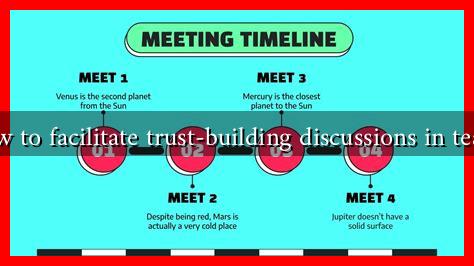-
Table of Contents
How to Facilitate Trust-Building Discussions in Teams
Trust is the cornerstone of effective teamwork. When team members trust one another, they communicate openly, collaborate effectively, and are more likely to achieve their goals. However, building trust within a team can be challenging, especially in diverse or remote work environments. This article explores strategies for facilitating trust-building discussions in teams, providing actionable insights and examples to help leaders foster a culture of trust.
The Importance of Trust in Teams
Trust enhances team dynamics and contributes to overall productivity. According to a study by the Institute for Corporate Productivity, organizations with high trust levels report 50% higher productivity and 76% higher engagement. Trust also leads to:
- Improved communication: Team members feel safe sharing ideas and feedback.
- Increased collaboration: Trust encourages cooperation and collective problem-solving.
- Higher morale: A trusting environment boosts employee satisfaction and retention.
Creating a Safe Space for Discussion
To facilitate trust-building discussions, it is essential to create a safe and inclusive environment. Here are some strategies to consider:
- Establish ground rules: Set clear expectations for respectful communication and confidentiality. This helps team members feel secure in sharing their thoughts.
- Encourage vulnerability: Leaders should model vulnerability by sharing their own experiences and challenges. This can inspire team members to open up.
- Use icebreakers: Start meetings with light-hearted activities that allow team members to share personal stories or interests. This can help break down barriers and foster connections.
Active Listening and Empathy
Active listening is a critical component of trust-building discussions. When team members feel heard, they are more likely to trust one another. Here are some techniques to enhance active listening:
- Paraphrase and summarize: Reflect back what others have said to show understanding and validate their feelings.
- Ask open-ended questions: Encourage deeper conversations by asking questions that require more than a yes or no answer.
- Practice empathy: Try to understand team members’ perspectives and emotions. Acknowledging their feelings can strengthen trust.
Utilizing Structured Discussions
Structured discussions can help guide conversations and ensure that all voices are heard. Consider implementing the following formats:
- Round-robin sharing: Give each team member a chance to speak without interruption. This ensures that quieter members have an opportunity to contribute.
- Fishbowl discussions: Create an inner circle of speakers and an outer circle of listeners. This format encourages active listening and allows for focused dialogue.
- Feedback sessions: Regularly schedule sessions where team members can provide constructive feedback to one another. This promotes transparency and accountability.
Case Study: Building Trust at Google
Google’s Project Aristotle, a study on team effectiveness, found that psychological safety was the most important factor in building high-performing teams. The company implemented various trust-building strategies, including regular check-ins, open feedback loops, and team-building activities. As a result, teams that prioritized trust saw significant improvements in performance and employee satisfaction.
Measuring Trust Levels
To understand the effectiveness of trust-building efforts, it is essential to measure trust levels within the team. Consider using:
- Surveys: Conduct anonymous surveys to gauge team members’ perceptions of trust and safety.
- One-on-one check-ins: Regularly meet with team members to discuss their feelings about trust within the team.
- Performance metrics: Monitor team performance and engagement levels to identify correlations with trust-building initiatives.
Conclusion
Facilitating trust-building discussions in teams is crucial for fostering a collaborative and productive work environment. By creating a safe space, practicing active listening, utilizing structured discussions, and measuring trust levels, leaders can cultivate a culture of trust that enhances team dynamics. As demonstrated by Google’s Project Aristotle, prioritizing trust can lead to significant improvements in performance and employee satisfaction. By implementing these strategies, teams can unlock their full potential and achieve greater success together.
For further reading on building trust in teams, consider exploring resources from the Forbes Human Resources Council.

